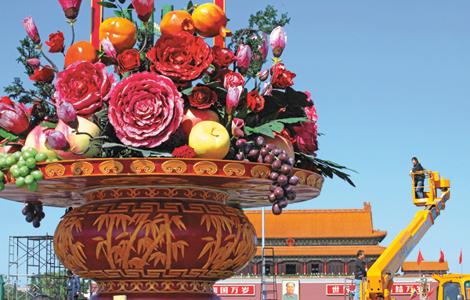Gardens put history and culture in perspective
Updated: 2013-10-07 07:20
By Peng Yining (China Daily)
|
||||||||
Related Story
Protecting country’s cultural treasures
When he visited Suzhou in 1952 as a senior architectural student, Liu Shaozong found no one was taking care of the city's classical gardens, some of which have since been listed as UNESCO World Heritage sites.
"There were people living in the gardens and centuries-old pavilions being used as stables. The plants were being eaten by horses and cows," said the 81-year-old landscape designer.
But even in their unkempt condition, the gardens deeply impressed Liu with their unique structure and well-designed details.
"You could find beautiful decorative patterns on windows and tiles," he said. "I am glad that the government soon paid attention and started to protect them before it was too late."
The gardens are now popular tourist spots in the city, but that popularity has brought other problems.
On National Day last year, more than 50,000 people visited the Humble Administrator's Garden, the most popular site that covers an area as large as eight soccer fields.
Even on days that are not in the peak season, the garden is filled with tourists and tour guides talking loudly through their microphones.
In the garden, there is one pavilion named "Stay and Listen", derived from a poetry verse: " Listen to the rain spattering on the remnant leaves of the lotus."
"But now it is impossible to listen to the rain, you can only hear the cameras whirr," Liu said.
"Crowds of people fly from all corners of the world to see the gardens, and the overload of visitors could harm the landscapes," said Wang Jintao, a professor of landscaping at Beijing Forestry University. "I have seen people picking flowers in the garden for souvenirs, or even carving their names on pillars. And the plants will stop growing if too many people visit and compact the earth."
Wang said the gardens should be protected from the public rather than being fully open to visitors. "Their value as cultural relics is more important than their tourism value," he said.
While some spots are suffering from an excess of visitors, other gardens desperately need attention.
The Garden of Cultivation, smaller than the Humble Administrator's Garden and hidden in a deep alley, is also a UNESCO World Heritage site and recorded 91 visitors on a Saturday in September.
Cheng Hong, director of a classical garden repair and development organization based in Suzhou, said he has spent 10 months in the city visiting more than 70 classical gardens which are not listed as historical relics.
"Once my assistant and I walked into a very humble and shabby building in an alley, but it turned out to be one of the most famous ancient libraries, which is more than 100 years old," he said. "These are not just gardens and buildings. They carry the city and even the country's culture, history and memory, which will disappear if we don't pay attention."
Lou Qingxi, director of the ancient Chinese architecture research center at Tsinghua University, said tourism is a double-edged sword.
"It attracts the public's attention and makes money to maintain the relics. The point of protecting the historical relics is so people can learn by visiting the sites," he said. "But the sites shouldn't be changed or destroyed for commercial purposes. It is supposed to be that tourism supports the sites, not the other way around."

 Williams beats Jankovic to win second China Open title
Williams beats Jankovic to win second China Open title
 Red alerts as Fitow closes in
Red alerts as Fitow closes in
 Disney's new heights
Disney's new heights
 East Asian Games open with subdued fanfare
East Asian Games open with subdued fanfare
 Boys will be boys
Boys will be boys
 Classic clash of the crickets
Classic clash of the crickets
 Albuquerque International Balloon Fiesta kicks off
Albuquerque International Balloon Fiesta kicks off
 President Xi arrives in Bali island for APEC meeting
President Xi arrives in Bali island for APEC meeting
Most Viewed
Editor's Picks

|

|

|

|

|

|
Today's Top News
US on path to default if Obama won't negotiate
China, NZ pledge to further ties, cooperation
Chinese, Australian leaders pledge to boost ties
Two Chinese die in plane crash near Saipan
US forces conduct twin raids in Libya, Somalia
Boehner: No idea when govt shutdown ends
Direction charted to resolve disputes
Destroying Syria's gas arms started
US Weekly

|

|






